Alinea Recipe, pages 332-335.
There’s nothing like the combination of pear with foie gras — it’s great with a little panna cotta and a glass of dessert wine after dinner. This recipe from Alinea Restaurant in Chicago combines them all into a perfect, compact bite. Yum! This is a two-day project if you allow time for curing your foie gras.
Day One
Foie Gras
If you object to foie gras on any grounds, you’re probably just not gonna like this recipe. On the other hand, if you enjoy the fantastically rich fatty flavor of goose liver, you’ll love this combination with sweet wine and tart pears. Never mind about the naysayers.
Previously, I’d purchased a lobe of humanely-raised Hudson Valley foie gras from Iowa Meat Farms (6041 Mission Gorge Road, San Diego, California 92120, 619-281-5766) for the GOOSE, Blood Orange, Sage, Roasting Goose Aromas recipe. I did not use all of it, so wanted to do this recipe in tandem.
Waste not want not.
It wasn’t quite as pretty as when I bought it, not as brightly pink colored. So I rinsed and cleaned it off, separating out some veins and other assorted “greeblies,” then cubed it.
In a small bowl, I tossed the foie with some combined salt, pink salt and sugar. Note: “pink salt” here refers to a type of salt containing nitrates used for curing meats — not rose-colored salt. I’m using Morton Salt’s retail version called “Tender Quick,” which contains salt, sugar, propylene glycol, sodium nitrate and sodium nitrite. Says Morton, “the salt acts as a preserving agent, along with sodium nitrate and sodium nitrite, which also contribute to color and flavor development.” Which is very true, as it was much brighter and pinker after it had cured.
Then compacted it in a vacuum bag, rolling it as tightly as possible into a cylinder. Then sealed to cure overnight in the fridge.
Ingredients
Hudson Valley foie gras, from Iowa Meat Farms
Morton® Tender Quick® curing salt
C&H cane sugar
Roast Pear Purée
I found some really nice Anjou pears at North Park Produce (3551 El Cajon Boulevard, San Diego, California 92104, 619-516-3336), one of my favorite grocers in the area. They have a ton of hard-to-find ethnic foods. While I was there, I even found canned truffles from Cypress (US$25.00/lb!!!), which I’ll try in the CHICKEN SKIN, Black Truffle, Thyme, Corn recipe later.
I poured a layer of kosher salt down in a roasting pan, then put the pears in (a little away from the edges) and covered with salt.
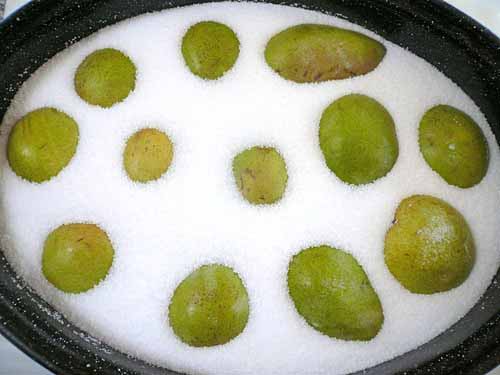
The pears just before I completely covered them in salt.
Roasted for about an hour in a 375ºF oven. Removed and let cool. Then started the archeological dig carefully with a spoon.
Then carefully dug them out from their hardened salt “chambers.” I found I had to use a delicate touch, or I’d smash them.
The excavated pairs. The remaining salt brushes right off is you don’t damage the skins.
Fresh next to salt-roasted.
About Salt Roasting
I was curious, and found a recipe by Martha Stewart. And Jamie Oliver uses this technique. An age-old cooking technique, salt roasting refers to baking an item while it’s encased in granulated salt, thus trapping in its flavors and juices.
A while ago when planning their new restaurant, Elena Rivellino and Dennis Stein of
Sea Rocket Bistro(closed, 3382 30th Street, San Diego, California 92104) experimented with salt-roasting fish.I tried a rock fish with the remaining pear-scented salt, and it turned out very moist and flavorful. And quite opposite of what you’d expect, its taste had just a hint of salt!
When baked this way, the pears’ juices harden the encasing salt around them, thus sealing them in their own “chambers.” Same way with fish. Any moisture and herbs will remain sealed up in the salt, steaming the items. Yum!
Skinned and cut up.
I puréed the pears in my Oster bar blender with some sugar until smooth. Then I ran the purée through a strainer and reserved to the fridge in a plastic container.
Ingredients
Anjous pears from North Park Produce
Diamond Crystal kosher salt
C&H cane sigar
Pear Sorbet Sherbet
Mise en place:

I combined the pear purée, cream, glucose, Trimoline, and a touch of salt in a medium saucepan and brought it to a simmer. Note: the use of invert sugars such as glucose and Trimoline stabilize the sorbet, lessening the crystallization of water when frozen, and giving it a smoother mouth feel.
Add the ice cream stabilizer and its just downright creamy smooth — for a sorbet…
Wait a minute. I thought a sorbet had no dairy in it. What’s the difference between ice cream and sorbet?
Let’s look it up.
Yep, I was right. This is more of a sherbet or gelato, rather than a sorbet.
Frozen desserts defined, courtesy of slashfood.com:
- Sorbet does not contains dairy; always very light in flavor.
- Sherbet (pronounced “SHUR bet” not “SHUR burt”) almost always has a fruit component, but also must contain dairy to produce a dessert that is lighter than ice cream, but richer than sorbet.
- Frozen yogurt contains dairy that has been cultured (though most do not contain active cultures), and is churned to resemble soft ice cream, with a smooth, rich texture.
- Ice milk just like an ice cream, but made with milk rather than cream; a little used term for strict constructionists of the word “ice cream,” since most home chefs would say ice cream anyway.
- Ice cream must have at least 10% milkfat (or 8% if there is a mix-in) by volume (if sold commercially); may or may not contain eggs.
- Frozen custard (also called French ice cream) ice cream that is made with at least 1.4% egg yolks, giving it a richer texture than ordinary ice cream.
- Gelato ice cream with a mixture of milk and sometimes cream in the base, often including eggs. It is churned less than regular ice cream and has less air in the final product, which gives it a dense texture.
I could not find the elusive Louis François STAB 2000 ice cream stabilizer, so a did a little research. Turns out chefs and foodies have been experimenting with more readily available hydrocolloids to substitute. STAB2000 is made with locust bean gum, so I figured the right combination of other gums might just do the trick. Following a lead from the Alinea Mosaic forum, I used a 50:50 ratio of guar bean gum and xanthan gum, half as much as called for in the Alinea recipe.
You can also use Stabi 3000 from L’Epicerie as a substitute. On a side note, if you’re wanting to keep your sorbets dairy-free and vegetarian, don’t use Danisco’s Cremodan stabilizers as they contain whey proteins and gelatins.
But I suppose that’s not much of an issue for this recipe, given the foie gras and all eh? 😉
Meanwhile, I combined the sugar, guar and xanthan gums in a glass bowl. Once it was completely mixed, I whisked it into the heated ingredients and brought to a boil. Then reduced to a simmer for about 5 minutes, whisking, until the stabilizers were incorporated and starting to thicken it up.
I tested my stabilizer hack on a small batch and found that I needed to adjust the amount down. The guar/xanthan mix made the final result a bit too elastic. If you go this route, test a small amount first. And please let me know what you come up with…
After it had cooked and thickened up, I removed it from the heat and whisked in the lemon juice. Let cool and then transferred to my ice cream maker. Ran that until it started to thicken, then popped it in the freezer.
What is Trimoline?
Trimoline® is a registered brandname for an invert sugar syrup paste manufactured by Erstein. Made from beet and sugar syrups, it is very concentrated and thick, used to prevent crystallization, resists humidity, acts as an anti-oxidant, increases caramelization, improves texture, preserves aroma, flavor, and color.
Inverted or invert sugar is a mixture of glucose and fructose. It’s made by splitting sucrose into its two components. “Compared with its precursor sucrose, inverted sugar is sweeter and its products tend to stay moist and are less prone to crystallization.” Invert sugar has a high affinity for water, and for this reason, it is used to keep products moist.
It works very well in sorbets and ice creams because it lowers the freezing point, virtually eliminating crystallization. Invert sugar acts as an emulsifier and helps stabilize the sorbet.
If you can’t find Trimoline, some on eGullet have suggested substituting honey, glucose or corn syrup. You can also try making your own. Other available brands of invert sugar syrup paste are Colorose, Honey-O, Inversol, Nulomoline and Nevuline.
Ingredients
Roasted pear purée, from above
Alta-Dena heavy cream
Diamond Crystal kosher salt
Glucose (Karo corn syrup)
Erstein Trimoline invert sugar syrup paste, from L’Epicerie
C&H cane sugar
Louis François STAB 2000 ice cream stabilizer,
or a mix of guar gum and xanthan gum
Freshly squeezed lemon juice
Day Two
Foie Gras (Continued)
The next morning I was ready to go again: time to push some foie. I removed the foie gras from the fridge and its bag, and let rest for about 15 minutes. Placed it on a double layer of cheesecloth.
Rolled it very tightly into a log and tied the ends with kitchen twine.
Blanched the foie cylinder in boiling water for 1.5 minutes, then removed to an icewater bath to cool for 5 more minutes.
I removed the foie gras from its wrappings and pushed it through a tamis drum sieve.
Unfortunately, it came out like mush, not the mini hamburger-like strands as shown in the book. Aaaargh!
So I froze it, then pushed it through a strainer (with a larger mesh than the fine tamis) with a wooden spoon. This seemed to work much better, and I got the stringy texture I wanted. I immediately put the foie back in the freezer until plating. It thaws and begins to melt very soon after being expose to room temperatures.
Pear Panna Cotta
I rehydrated some gelatin sheets in cold water, squeezed them dry(ish), and added to my mise en place:
I combined some pear purée, cream, sugar, the gelatin and a touch of salt in a medium saucepan. Brought it to an almost-simmer, whisking, to thoroughly dissolve the solids and incorporate the gelatin. Removed from the heat.
I decided to prepare this a little differently than as outlined in the recipe. In it, they require eight ring molds or round cookie cutters; that would be seven more than I have in one size. I thought of making some with sheet copper, or lexan plastic sheets.
Nawwwh. I’ll just do it the GREEN ALMOND, Sweet, Hot, Sour, Salt way.
I lined a 9×12 glass baking dish with some plastic wrap, just as I’d done before in other Alinea gelatin-based recipes, like BLACKBERRY, Tobacco, Smoke, Bee Balm, or KING CRAB, Vinegar, Aromatics, Seaweed. Then poured in the pear panna cotta, and reserved to the fridge to set up while I completed the Sauternes Gelée.
What’s panna cotta?
Panna cotta (pawn ah COAT ah) is Italian for “cooked cream.” It’s simply a dessert made by simmering together cream, milk and sugar, adding gelatin, and letting it cool until set. Usually topped with a sauce, fruit, chocolate, (or all of the above, mmmm).
Ingredients
Rousellot “silver” gelatin sheets, from L’Epicerie
Roasted pear purée, from above
Alta-Dena heavy cream
C&H cane sugar
Diamond Crystal kosher salt
Sauternes Gelatin
This is so simple to make. Two ingredients: wine and JELL-O.
Earlier in the week, I bought a bottle of 2005 Chateau de Malle Sauternes (US$24.99) at BevMo. Sauternes (so-TAIRN) is a sweet dessert wine that comes from the Bordeaux region of France. Not to be confused with the cheap sauterne cooking wine (uncapitalized and no “s” on the end). You could equally use any of your own favorite sweet, after-dinner dessert wines.
I rehydrated some gelatin sheets in cold water, squeezed them dry(ish), and added to my mise en place:
I heated up the wine in a small saucepan, then added the gelatin, whisking to dissolve the solids. Then removed from the heat to cool to room temp.
After it had cooled, I removed the pear panna cotta from the fridge. I poured the Sauternes over the pear panna cotta and returned the dish to the fridge to set.
Ingredients
Rousellot “silver” gelatin sheets, from L’Epicerie
Sauternes cooking wine
Pear Chips
I sliced a pear in half lengthwise from top to bottom, then sliced them up as thinly as possible on my meat slicer.
I combined the water and sugar in a medium saucepan, brought it to a boil to dissolve the solids, and reduced the heat to a simmer. Dropped in the pear slices and cooked until they were tender and translucent (about five minutes for my slices/stove). I removed the pan from the heat and let cool to room temp.
I cut out one-inch rounds from these with a cookie cutter.
I dehydrated them at 135ºF on a Silpat matt in my American Harvest dehydrator. It took about 4 hours.
Then reserved in a plastic container to my prep area.
Ingredients
Anjou pears, from North Park Produce
Water
C&H cane sugar
Anise Hyssop Leaves
As the late Clara Peller used to decry, “Where’s the beef?”
This recipe is called PUSHED FOIE GRAS, Sauternes, Pear… and Chervil. But Chervil is not listed in the ingredients, nor in the recipe, which calls for anise hyssop leaves instead.
About Anise Hyssop
Anise hyssop (Agastache foeniculum) is a member of the Lamiaceae (Labiatae), or mint family, also known as anise mint, giant hyssop, and licorice mint. It has a pronounces anise flavor, thus the name.
“The leaves look a bit like catnip, another mint-family member, but larger. Herb lovers claim it as a culinary herb, using the fresh or dried leaves in tea and crumbling the tangy flowers over fruit salad — but the wildflower books list it as a native wildflower of north-central North America. And though it’s called hyssop, it’s not the hyssop, Hyssopus officinalis, a blue-, pink- or white-flowered European member of the mint family traditionally used as a healing herb.”
Source: The Herb Companion, photo courtesy Eli Malone, elicooks.com.
Ingredients
Micro chervil, anise hyssop, or basil mint leaves
To Assemble and Serve
I removed the layered gel from the fridge and cut out portions with a two-inch diameter muffin cutter.
Placed each on a plate, positioning the cutter back around the gel. Using a muffin cutter is great, cause it’s taller than your ordinary cookie cutter. This will make a wall to hold in the foie. I removed the pushed foie from the freezer, then gently added a layer atop the gel, carefully removing the ring mold.
Then repeated for each other plating. Gotta do this quickly, as the fine foie gras pieces thaw quickly.
Then topped with a quenelle (my first ever!) of pear sorbet, a pear chip and sprinkles of basil mint. I had neither chervil, nor anise hyssop. But I did have some basil mint leaves left over from a previous recipe.
Serveware
Plain, round white dinnerware
Equipment
Salter digital scale
Measuring bowls
Cutting board and kitchen knife
Paring knife
Roasting pan
FoodSaver V2240 vacuum sealer
Sous vide immersion circulator, or large stock pot and thermometer
Wooden spoon, rubber spatulas
Tamis, strainer and sieve
Osterizer bar blender
Ice cream maker or PacoJet
American Harvest dehydrator
Stainless steel bowl
Paper towels and sheet tray
Plastic containers
Yields: 8 Servings, with about 8 more gelée pieces left over.
Revised, 12 Feb 2018.
Next, BEEF, Elements of A-1.
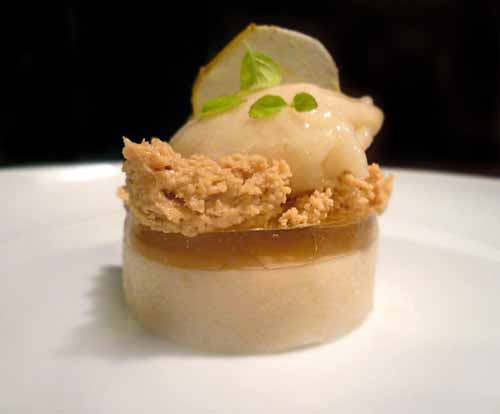
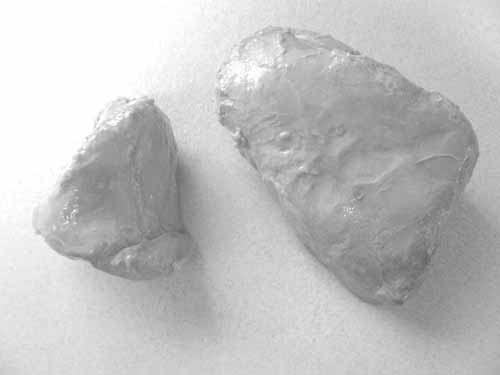


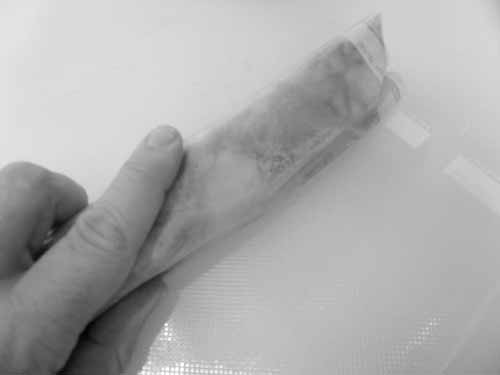

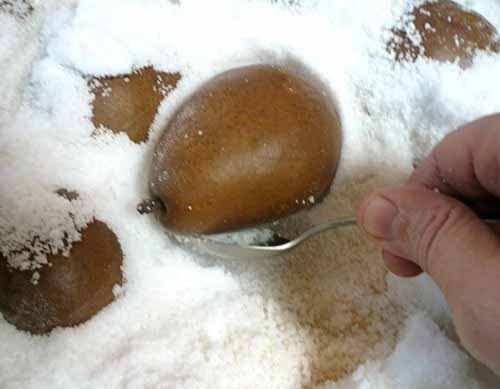
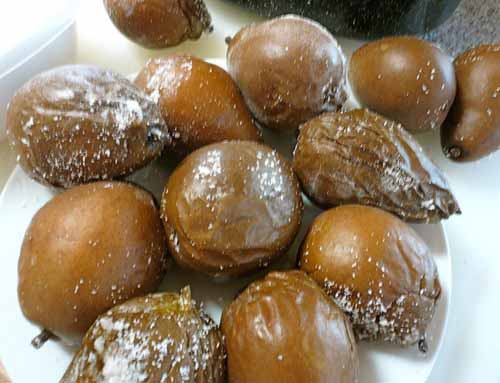
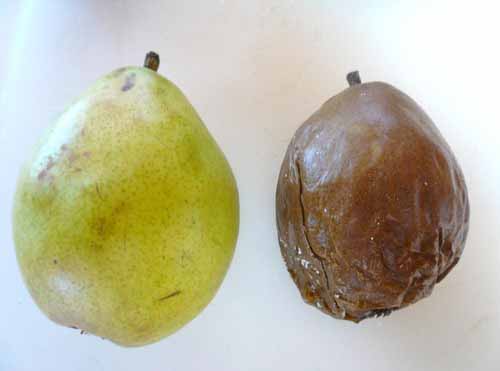
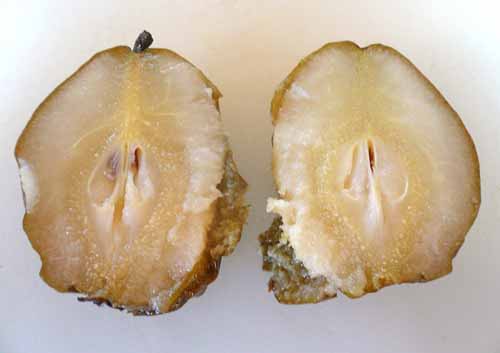

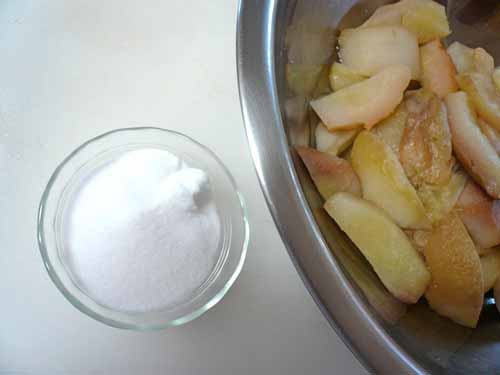
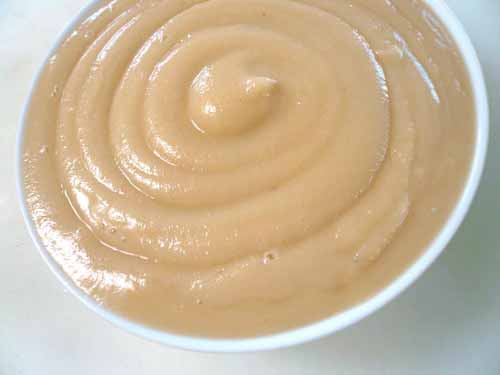
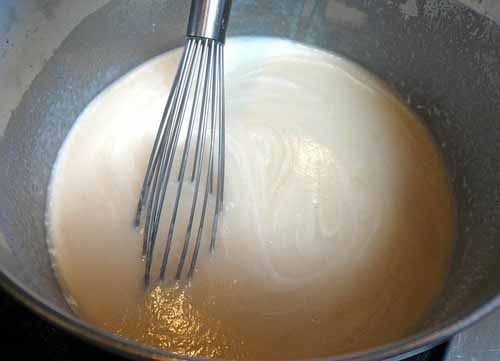

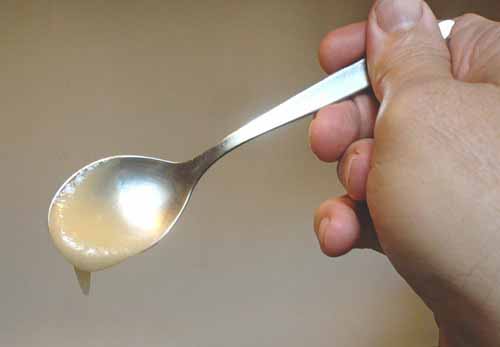
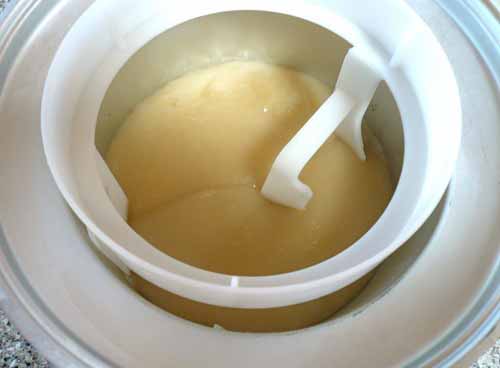
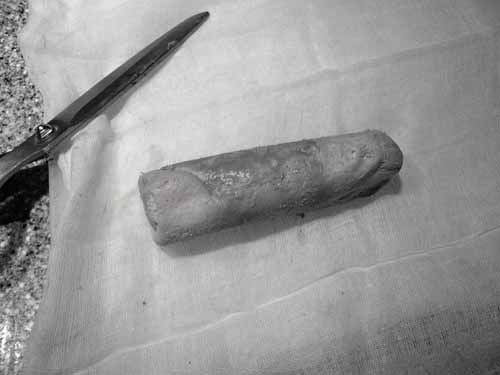
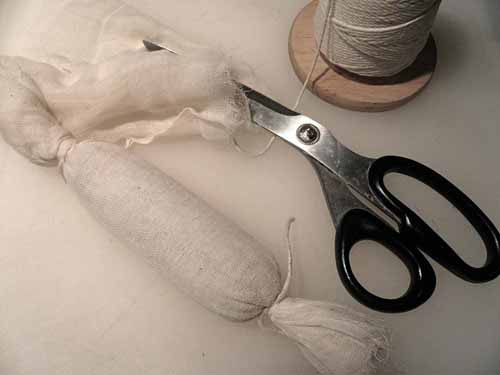



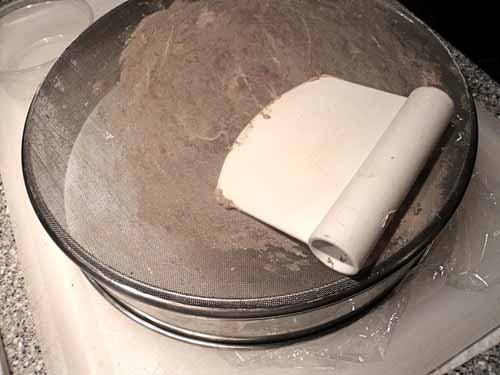


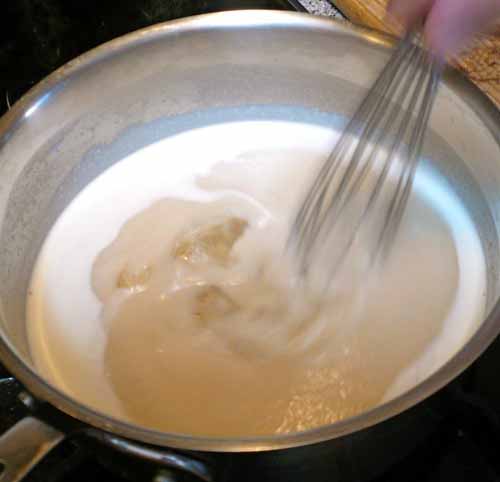


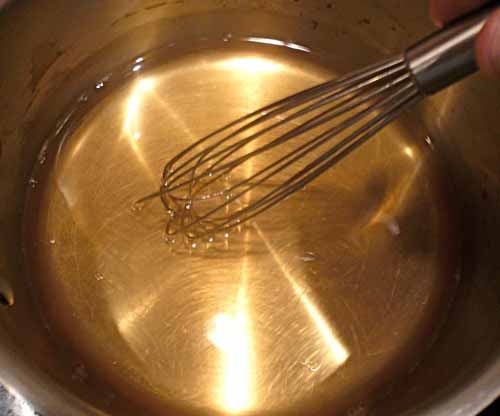
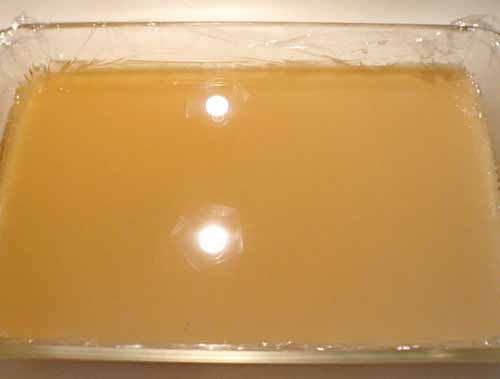
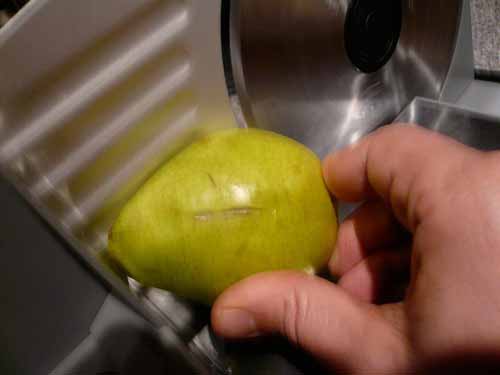
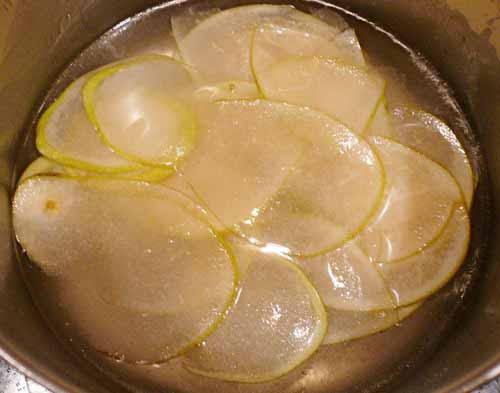


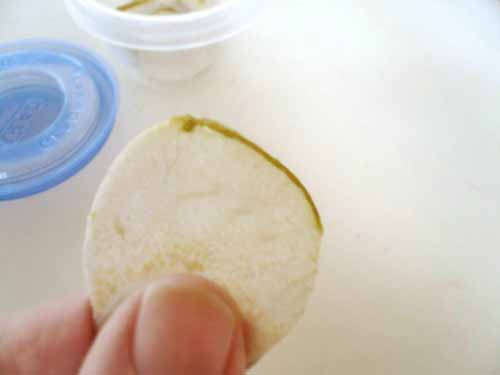
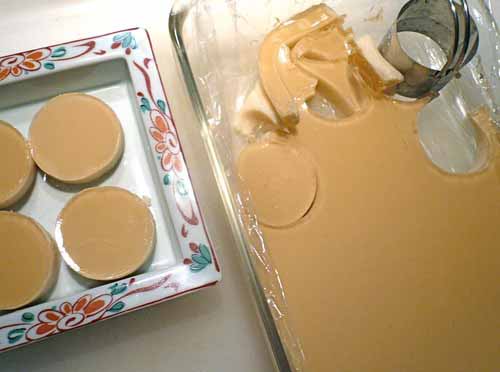

Pingback: PUSHED FOIE GRAS, Sauternes, Pear, Chervil « Secret Foods